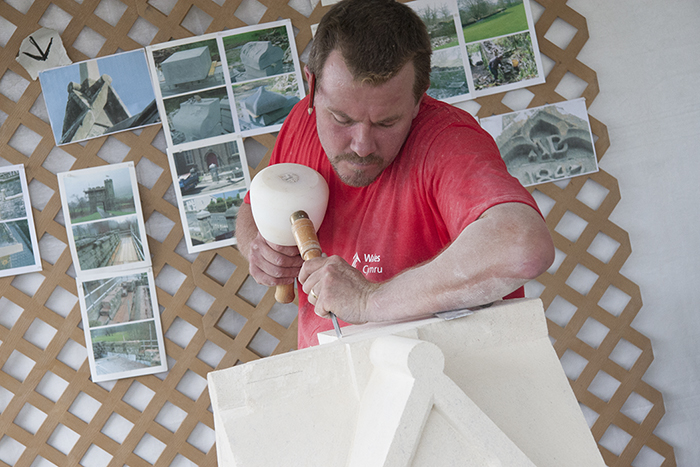As you enter the reception area of the Center for Folklife and Cultural Heritage, a distinctively carved limestone block anchors the far edge of the seating area. If you’re not sure what it is, you would not be alone in wondering.
It is, in fact, a beautifully carved Welsh apex stone—the decorative building block mounted to the top gable of a church, serving as the base for its cross. Master stonemason Selwyn Jones carved this stone during the 2009 Smithsonian Folklife Festival as part of the Wales Smithsonian Cymru program. By all accounts, he was a highly skilled participant and a captivating presenter. His tent was always filled with people watching him work, asking him questions, and trying their hand at chiseling and carving stone.
In Wales, the term “stonemason” is applied to many aspects of the trade. With nearly thirty years of experience, Jones is adept in many areas, including stone sourcing, wall building, and carving. He first trained as a metal sculptor, then apprenticed to a stonemason, and currently specializes in restoration work. In his own words, he is “passionate about traditional skills” and openly shares his enthusiasm. Restoring historic buildings gives them new life, and being part of that process connects Jones directly to the roots of his heritage.
“Anything to do with stone, we can restore it,” Jones explained at the Festival. This can include taking a building completely down and rebuilding it, replacing a few stones, or—in the case of an apex stone—replicating the shape and design of that distinctive church feature. For visitors to Jones’s tent, photographs of works-in-progress in their local setting helped provide context for what he was creating. The pictures were also a testament to the strong preservation policies of the Welsh government, which established the environmental division of Cadw (meaning “to keep” or “to protect”) in 1984 to help sustain the distinctive character of Wales’s landscapes, buildings, and towns. This is done in part through restoration and also by providing public access and education.

The Wales Cymru program was built around the theme of sustainability. Centuries of tradition, change, and innovation have resulted in Wales’s current reputation as a world leader in sustainable practices. Few things in architectural practice are more sustainable than historic preservation—an endeavor that maximizes the use of existing materials, reduces waste, and helps preserve the identity-giving character of a community and its institutions. As curator Betty Belanus wrote in the 2009 program book, “sustainability is built upon the rediscovery and reinterpretation of older practices.” Understanding those traditions instills pride in the past and can hold solutions to challenges faced today.

The four-pointed apex stone Jones created at the Festival is made of English limestone, a building material known for its tight, smooth grain that “holds the cut well.” The layout of the design allowed him to work on all sides of the stone. He described and demonstrated the properties of each tool and let visitors assist in chipping out the recessed areas of the stone. The designs are a sampling from work he has done, and two are common to apex stones: a trefoil (three-lobed plant) and cusps (the point of intersection where two arcs meet). The third is an abstract Welsh dragon, and the fourth is new: the Smithsonian’s sunburst!
Shortly after the Festival ended, the Wales Heritage Lottery Fund announced a series of grants to support on-the-job training for people interested in acquiring heritage building skills. Jones greeted this news enthusiastically and immediately offered to take on placements in stonemasonry. He was also “extremely keen” to encourage women to work in the field. His wife works with him as a stonemason—and was with him at the Festival. As a final word, he said, “You don’t need physical strength, but you do need patience!” Many who tried their hand at carving stone at the Festival would agree!
Read more about the stonemasons and watch a short video of Selwyn Jones at the 2009 Festival.
Erin Younger is a research associate working on the material culture collection at the Center for Folklife and Cultural Heritage. Years ago she worked as a cultural resource specialist at Seattle’s King Country Historic Preservation Program and retains an abiding affection for the building arts.


